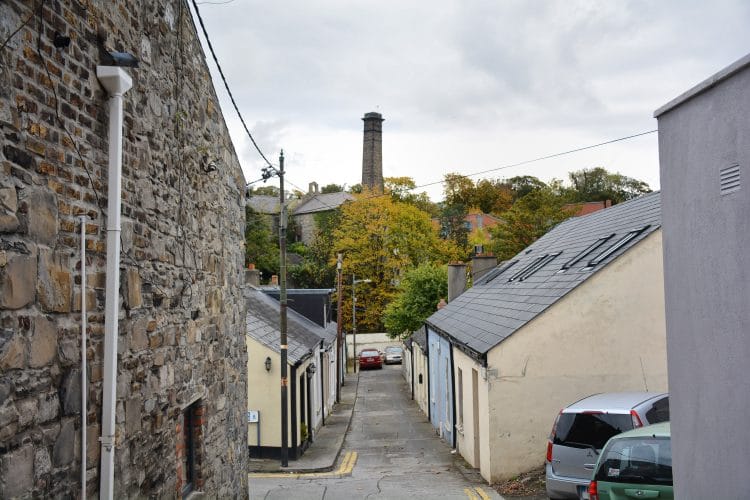What’s the best way to tell area residents about plans for a new asylum shelter nearby?
The government should tell communities directly about plans for new asylum shelters, some activists and politicians say.
Spread over more than 3,000 square metres, the old mills site in Kilmainham has been empty since the year 2000. Plans for it have come and gone.

There were high hopes for Kilmainham Mills.
Back in 2003, then-owner Damien Shine’s company Charona Ltd was in line to redevelop it, with plans for 48 new residential apartments. Thirteen years later, the mill still sits idle.
Despite the efforts of Dublin City Council and Kilmainham residents in the interim to repurpose the historic building, that may be off the table now too.
Kilmainham Mills sits along the Camac River, which eventually joins the River Liffey. Spread over 3,395 square metres, it lies not far from Kilmainham Gaol and the Irish Museum of Modern Art.
According to the Kilmainham and Inchicore Heritage Group, it was in continuous use from the sixteenth century until 2000.
Today, it’s overgrown with ivy and weather-worn and vacant. “It was really stuck in the mud, but now it’s really stuck deeper than it ever was,” says heritage group secretary Michael O’ Flanagan. “It’s continuously deteriorating.”
The origins of the mill’s proposed redevelopment stretch back 14 years.

In 2002, Dublin City Council drew up a conservation plan for the site. It “recommended that the archaeology of the site be disturbed as little as possible and laid particular emphasis on the historical development of the Mill Race when it was internal to the Mill building,” said an Irish Times report in November 2003.
The conservation plan listed structures within the mill in order of historical importance, and was prompted by Shine’s efforts at the time to redevelop the site.
In February 2005, Shine was granted planning permission for the 48-apartment development. Yet, somewhere along the line, things took a turn.
When the plan for apartments didn’t come through, Dublin City Council and a company named Kilmainham Mills Ltd tried to revive the mill and reopen it as a possible heritage centre.
Maurice Coen, a Kilmainham resident, established Kilmainham Mills Ltd in 2013. The company was set up at the behest of Dublin City Council, according to Coen.
“The plan was that [the council] would go forward, purchase the mill and it would be handed over to our group,” he says. “We would then have a 10- to 15-year company contract to build it into a visitor centre.”
When Kilmainham Mills Ltd was established, there were numerous EU conservation and heritage grants available, says Coen. The idea was to fund the centre with money from some of those, he says.
“The mill’s still pretty sound, but the roof is coming in in many, many areas,” says Coen. “My argument was that with every rainfall, every storm, more damage is being caused. The price of reconstructing would be dramatically increased.”
But there was an obstacle for Coen and the council.
Shine still lives within the grounds of the mills today, according to Coen and heritage group secretary O’Flanagan, as the de facto caretaker of the site. I tried knocking on the door, and going around to the back yard, but was unable to contact Shine.
The debts incurred from the failed 2003 redevelopment eventually came under the remit of the National Asset Management Agency (NAMA). Charona Ltd was liquidated, and the mills was listed on a 2011 spreadsheet of NAMA-enforced properties, circulated on thestory.ie.
According to Coen, the council was determined to bargain with NAMA to get the property.
“They had an arrangement set up with NAMA,” he says, “Brendan Kenny [Dublin City Council’s assistant chief executive] had a great interest in acquiring the premises. He felt it would have made a fantastic tourist attraction.”
(Dublin City Council has yet to respond to queries about its involvement with Kilmainham Mills.)
“I believe that they made some offers of property and possibly money as well to try and get [Shine] to vacate the premises,” says Coen.
It may no longer matter, he says.
Coen says he has heard that “an American company had purchased it five to six weeks ago”.
No new application for planning permission has been made in relation to the Kilmainham Mills site. And it can be quite difficult to determine ownership of a property in Dublin.
If it is under new ownership, Coen wants to know how much it was disposed for. And until he is sure what is planned now for the new site, Kilmainham Mills Ltd will remain operational as a company, said Coen.
“It’s a heritage site, it shouldn’t be done away with as such,” he says.